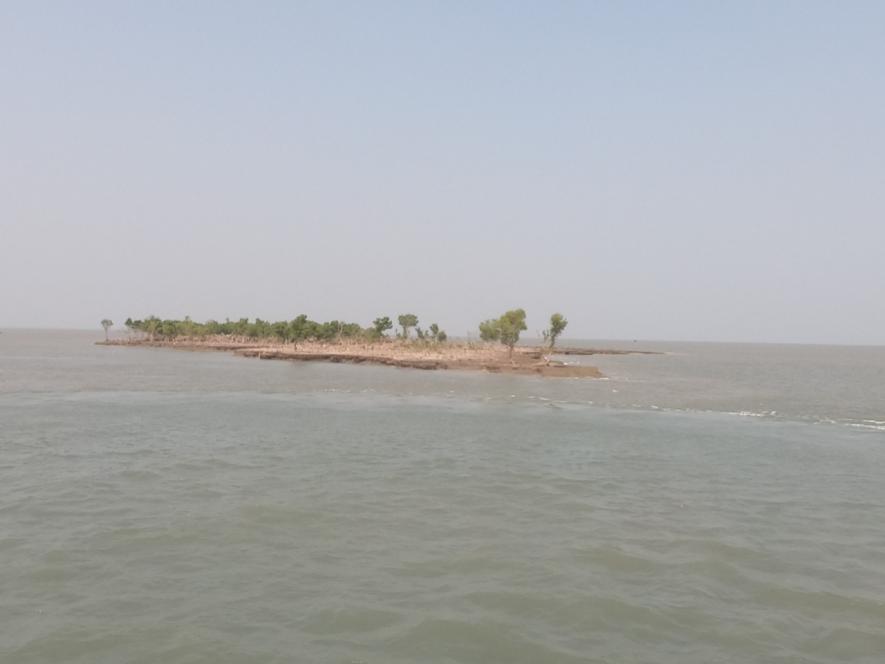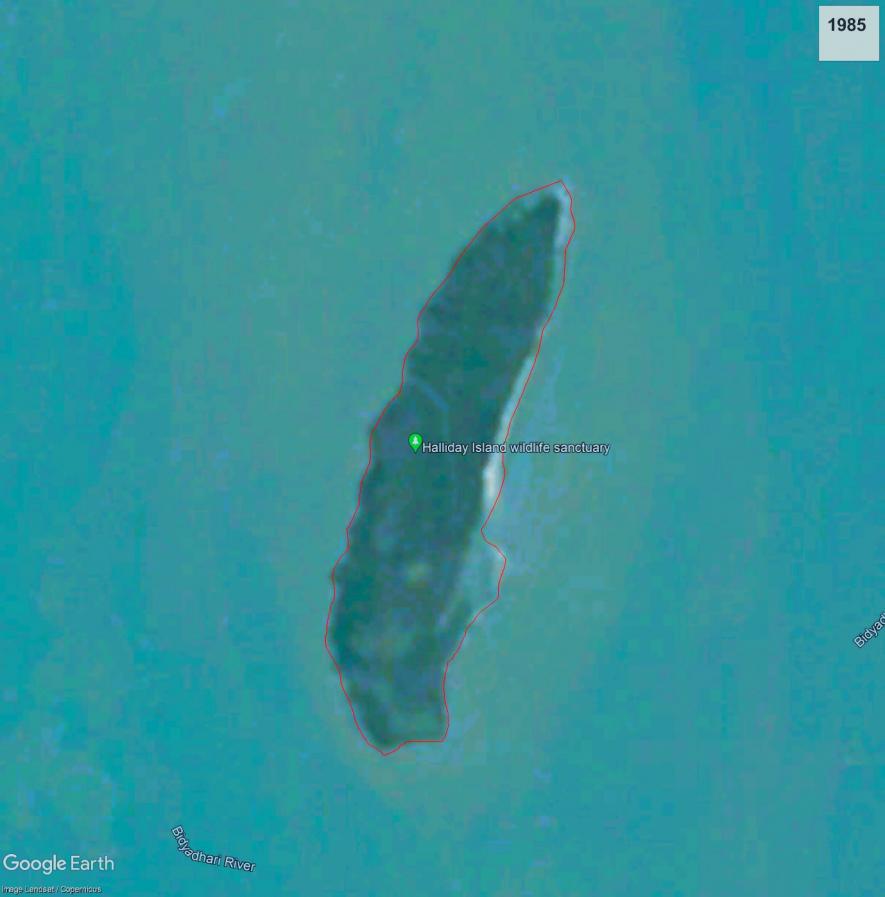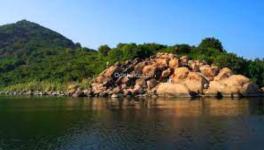India Calls for Action at COP27 as Sundarbans Wildlife Sanctuary Shrinks to Less Than 1%

A view of the southern side of the fast-vanishing Haliday Island Wildlife Sanctuary. Picture credit: Punarbasu Chaudhuri.
New Delhi: India presented its disaster management preparedness and early warning system development at the launch of the United Nations ‘Early Warnings for All Executive Action Plan’ during the ongoing COP27 climate summit in Sharm el-Sheikh, Egypt, on November 7. Environment minister Bhupender Yadav called for an urgent need to “acknowledge the cascading natural hazards that cause substantial losses around the world”.
Ironically, things are not okay in India’s own backyard with the government oblivious to the alarming submergence of a notified wildlife sanctuary in the backwaters of the Sundarbans delta presumably due to extreme weather events like cyclones or rise in sea levels.
No action plan is in place for the retrieval and reclamation of the Haliday Island Wildlife Sanctuary, located in the middle of the Matla River in West Bengal’s South 24 Parganas district, which has shrunk to less than 1% of its original size in the last more than 40 years.

The Haliday Island, in the Sundarbans, as seen in 1985. The island’s size has been alarmingly decreasing since 1976.

The Haliday Island Wildlife Sanctuary has shrunk to less than 1% from 595 hectares to 4 hectares in the last more than 40 years.
Only four hectares (0.04 sq km) of the 595 hectares (5.95 sq km) measured when the area was notified in June 1976 are left. The island is part of the Sundarbans Biosphere Reserve, which was identified as a UNESCO World Heritage Site in 2001.
Many species of flora and fauna face imminent extinction if the island is completely submerged in the near future. Shockingly, neither Central and state government agencies responsible for monitoring and protecting wildlife and forestry have any data on the ecological damage caused to the sanctuary nor has a study on the possible causes for its alarming submergence been conducted.
On November 11-12, a team of five researchers from Calcutta University undertook a four-hour journey by boat to the island to assess its condition.
“The situation at the wildlife sanctuary is dire. It is likely to get obliterated if no action is taken. Presumable reasons for the shrinkage of the wildlife sanctuary appear to be erosion and certain anthropogenic factors,” Punarbasu Chaudhuri, associate professor at the university’s environment department and team leader, told Newsclick. “A detailed study is immediately required to restore the island.”
According to state forest department officials, the island’s history dates back to the eighth century when it was known as Jinjir and was probably a stopover point on the maritime trade route between India and Arab countries. It was renamed Haliday Island after Bengal’s first lieutenant governor Sir Frederick James Halliday in the 19th century. The British used the island as a game sanctuary and hunting ground, officials said.

The island does not have any human habitation and is only accessible to forest department officials. The study team had obtained permission from the forest department to visit the island.
“Our preliminary observation suggests the presence of several species of unique birds on the island. Local fishermen communities from the mainland also find a good catch of fish along the island’s coasts. A detailed study is required to draw up the inventory of the flora and fauna following which conservation measures could be taken,” added Chaudhuri.
The 1976 state gazette notifying the island as a wildlife sanctuary states that it is of “adequate ecological, faunal, natural and zoological significance”. Government archives, however, contain very little information about the island’s ecological significance when it was notified.
A research paper on the mangrove forests of the Sundarbans states: “Halliday Island Wildlife Sanctuary is a small island in the middle of the Matla River and is one of the most important staging grounds for wintering waders. Thousands of small waders, mainly Lesser Sand Plovers, use the sand flats on the southern parts of the island.”
Many species of plants, animals and birds are found in and around the Halliday Island Wildlife Sanctuary, as per a document prepared by the forest department on the abundance of wildlife in the region. The list mentions seven different types of fauna, including estuarine crocodile, horseshoe crab and the Gangetic dolphin, which has been classified as an endangered species under the Convention on International Trade in Endangered Species of Wild Fauna and Flora or CITES, which was signed by India.
The list also mentions 47 species of birds most of which are abundantly found in and around the island. It also includes a list of 26 plants found in different proportions in the region.
“In addition, hundreds of hermit crabs and some sea snakes have also been sighted in the region. We are still trying to figure out any study listing the flora and fauna of the sanctuary. Such a study, if at all, could serve as the baseline data to compile a proper inventory of wildlife in the sanctuary and the ecological damage caused by the island’s shrinkage,” South 24 Parganas divisional forest officer Milon Kanti Mandal said.
“The island is not suitable for mangroves. The erosion could have taken place due to some extreme microclimatic process. Sand has deposited in the northern side of the island, which reportedly used to be a nesting site for Olive Ridley turtles,” added Mandal.
A management plan for the sanctuary, according to the forest department, in consultation with experts and scholars from research institutions and universities is being formulated and a comprehensive report is expected within a year.
The vanishing wildlife sanctuary was never a part of the agenda of the meetings of the National Board for Wildlife (NBWL), a statutory organisation responsible for the conservation and protection of wildlife.
The National Remote Sensing Centre (NRSC), of the Indian Space Research Organisation (ISRO), manages data from aerial and satellite sources for disaster management support, governance and capacity building.
However, NRSC’s forest biodiversity and ecology division head C Sudhakar Reddy told Newsclick that the organisation doesn’t have any information or data on Haliday Island.
There is ambiguity even regarding the island’s current size. Forest department officials claim that its size is more than four hectares because the satellite images were obtained during high tide while researchers contend it is lesser but can be exactly measured using the Global Positioning System. The satellite imagery study used in this article was done by Legal Initiative for Forest and Environment (LIFE) through its researcher Subhrajit Goswami
According to experts, the protected area will meet the fate of the Megapode Island Wildlife Sanctuary, on the Andaman and Nicobar Islands, if immediate action is not taken to halt the erosion of the island’s coasts.
The Megapode Island, once known for its rich flora and fauna, including the terrestrial scrub-fowl Nicobar Megapode—unique to the archipelago in the Bay of Bengal—was submerged in the December 2004 tsunami. The NBWL’s standing committee de-notified the Megapode Island in January 2021 on the grounds that its submergence did not any longer serve any purpose for the conservation of the Nicobar Megapode.
Though the NBWL later recommended measures for the conservation of the Nicobar Megapode on other islands—the Wildlife Institute of India had prepared a conservation action plan too—the bird is apparently rarely seen.
The writer is an independent journalist.
Get the latest reports & analysis with people's perspective on Protests, movements & deep analytical videos, discussions of the current affairs in your Telegram app. Subscribe to NewsClick's Telegram channel & get Real-Time updates on stories, as they get published on our website.
























